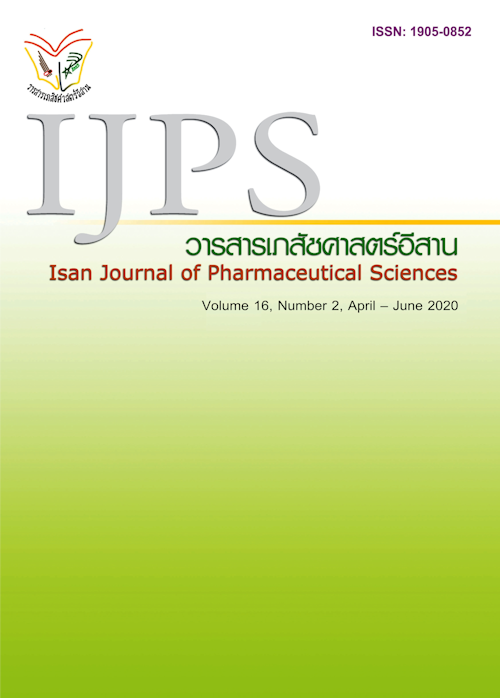The surveillance outcome comparative of unsafe cosmetic products distribution in shop and salon, Sukhothai province Year 2017-2018
Main Article Content
Abstract
Introduction: Cosmetics are part in daily life. People make a decision to select cosmetic products under the factors relating to prices, selling channels and sales promotions. Nowadays, the modernization of technology and consumer behavior have changed. Contamination of prohibited substances in some cosmetic products urges a guideline to monitor the sale of cosmetic products and standardized the control of selling places with the aim of providing safety to people. Objective: To compare the results of monitoring unsafe cosmetic products in shops and beauty salons in Sukhothai 2017-2018. Methods: The study was quasi-experimental research conducted with 115 shops and beauty salons during January 1, 2017 to June 31, 2018. The research consisted of; 1) exploring experimental places and making random of the samples of cosmetics to evaluate prohibited cosmetic items, cosmetic labels and prohibited substances; 2) analyzing problems and seeking for monitoring guidelines; 3) monitoring sale of unsafe cosmetics in 9 months; 4) exploring experimental places and making random of the samples of cosmetics to evaluate prohibited cosmetic items, cosmetic labels and prohibited substances. The data was analyzed in forms of frequency and percentage. Results: After the continual monitoring of sale of unsafe cosmetics in shops and beauty salons in Sukhothai in 2018, more cosmetic shops and beauty salons met the standards. Prohibited cosmetic items with incorrect labels according to the announcement of the Ministry of Public Health reduced 0.66% and 6.30% respectively. The cosmetic labels did not identify numbers or letters of production date and expiring date. In addition, prohibited substances in the cosmetics were examined by using a preliminary testing kit. It was found that in 2017, 82.61% was mercury, hydroquinone and vitamin A acid. However, in 2018 only mercury was found (16.67%). Conclusion: The Ministry of Public Health should cooperate with associate networks and communities to monitor unsafe cosmetics and to continually publicize to enable people to have safe cosmetic use sustainably.
Article Details
In the case that some parts are used by others The author must Confirm that obtaining permission to use some of the original authors. And must attach evidence That the permission has been included
References
Chatchawankitkul N, Surpakdee D. The unique store design factors affecting purchase decision making of Korean imported cosmetics. Independent study in Master of Business Administration (Entrepreneurship) Silpakorn University 2011: 1-59.
Cosmetics Act 2015. Royal Thai Government Gazette (Announced 2015, September 9). Volume 132 Section 86, page 5 [online]. [cited 2019 September 17]. Available from: library2.parliament.go.th/giventake/content_nla2557/law86-080958-5.pdf
Prawatruangsri M, Maneesong O. Buying Decision Process of Generation Y Women in Mueang Chiang Mai District Towards American and European Facial care Cosmetics. Thesis in Master of Business Administration (Marketing) Chiang Mai University 2014: 4-9.
Public Health Ministry Announcement: List of cosmetics prohibit in production, importation, distribution 2016. Royal Thai Government Gazette (Announced 2016, March 28). Volume 133 Special section 72, page 21 [online]. [cited 2020 May 13]. Available from: http://www.ratchakitcha.soc.go.th/DATA/PDF/2559/E/072/21.PDF
Ratanasirisap K, Jariangprasert N, Watanakun N, Saiprasert W. The Use of Bulletin Board Data from Internet for the Purchasing Decision Process of Cosmetics : A Case Study of a Suanlumpini’s Nutrition and Beauty Chat Group at www.pantip.com. Thesis in Master of Business Administration Chiang Mai University 2003: 4-20.
Rattananamanee S, Maneesong O, Bunchua E. Customer Perception Towards Image of Imported Cosmetic Products in Mueang Chiang Mai District. Thesis in Master of Business Administration (Marketing) Chiang Mai University 2008: 4-12.
Royal Institute Dictionary. Cosmetic [online]. 2011 [cited 2019 September 17]. Available from: http://www.royin.go.th/dictionary/
Ruenruay S, Chalongsuk R. Development of consumer protection network on cosmetics in community: A case study of Tambon Ban Rai, Amphor Ban Rai, Uthai Thani. Thesis in Master of Pharmacy Program (Consumer Protection in Public Health) Silpakorn University 2012: 1-190.
Sukcharoenchaikitch P, Lochid-Amnuay S, Amrumpai Y. Melasma or whitening creams selections in teenager: case study of Amphoe Banpong Ratchaburi. Thesis in Master of Pharmacy Program (Consumer Protection in Public Health) Silpakorn University 2009: 1-76.
Suksomnirundon P, Rompho N. The study of customer satisfaction on the purchasing of premium cosmetic brands in first jobber. Thesis in Master of Business Administration Thammasart University 2015: 1-60.
Tujindar T, Kaeosawan C. Factor affecting purchasing decision for cosmetics importing from Asean countries of Burapha university’s student Thesis in Master of Business Administration Burapha University 2015: 1-72.
Yoopan N, Duangchan P. Label Reading Behavior before Buying and Using Drugs and Cosmetics among Undergraduate Students at Srinakharinwirot University. Thai Pharmaceutical and Health Science Journal, Vol. 5 No. 2, Apr. – Jun. 2010 p.121-130.


